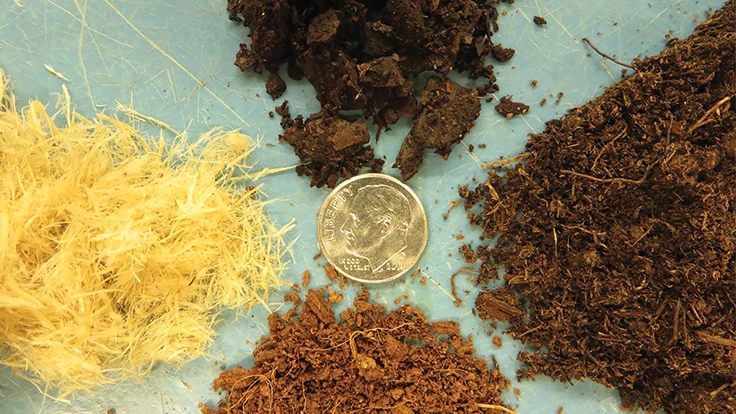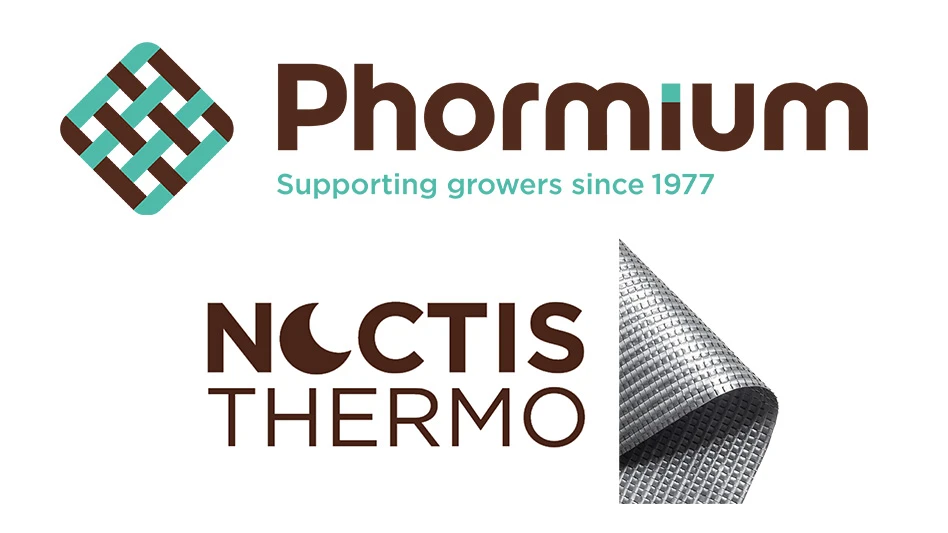

Growing plants in ground-up trees? Really? What has the world come to!?! A few years ago, this topic or concept would likely be a very strange and foreign one to you, but today you are likely already somewhat familiar with this trend. Maybe best stated or viewed as supplements, extenders or alternatives to traditional substrate components (Fig. 1) instead of “replacements,” wood substrates continue to garner interest from coast to coast and across continents.
A significant amount of scientific research has been conducted on the use of wood substrates over the past three decades. Equally as important as the work completed by academic and industry scientists is the work and trials completed by growers across North America and Europe. Confidence has risen in recent years (notably since 2015) based on a variety of factors including the consistency of results across differing studies, similarity of data and results on the East Coast and West Coast, repeated results from trials spread out over a decade, notable positive plant growth response across a wide range of species and production system types, etc. Over the past three decades, more than 25 tree species have been tested for their potential in substrate use (Fig. 2). The majority of all trials conducted agree that soft wood trees (conifers) perform better than their hardwood cousins. Pines, spruce, fir and larch trees lead the pack in both North American and European current wood fiber production. Numerous trials have been successful in growing crops in 100 percent pine wood (Fig. 3) even though current wood percentages in commercial mixes are in the 10-40 percent range. Observations and rumors suggest that as growers and substrate manufacturers become more comfortable and confident growing in these lower percentages that they will begin (as some already have) using higher rates closer to 100 percent if their management parameters can be shifted to account for the different growing needs (irrigation, pH management, fertility, postharvest shelf life durability, etc.).
Why wood?
The southeastern U.S. is known as the woodbasket of the world for a good reason. In 1952 there were an estimated 1.8 million acres of pine plantations in the South. Fast forward to 2007 and the acreage increased to around 32 million! According to the reference text, Forest Resources of the United States, Southern pines are the most important forest crop in the South, accounting for about 80 percent of all trees planted in the roughly 45 million acres of managed forest lands. These pine trees are grown primarily for pulpwood and other conventional forest products (poles and pilings, veneer or plywood, saw timber, etc.). The USDA Forest Service projects that pine plantations will expand by as much as 70 percent in the next 50 years with an estimated 47-67 million acres of managed pine plantations in the U.S. existing in 2060.

If wood is to be plentiful in the decades to come, despite existing and emerging markets (pellet industries, cellulosic biofuels industry, cogeneration power systems, etc.) there can be some certainty that this resource is sustainable and plentiful/bountiful enough to support long-term product development and support industry-wide product demand. However, if access to wood chips/feedstock remains tied to the forestry industry and normal harvest patterns (directly influenced by the economy and housing markets) then there is always the possible concern of supply and availability issues even if plenty of trees are standing in the forests. This scenario, which hopefully never happens, brings up the forward-thinking and proactive approach to wood source security: owning land and managing forests for the specific goal of making substrates. Think about it! From seedling to substrate… growing pine trees for complete dedication and utilization in horticultural use. Some growers are already doing this and I think some of the more forward-thinking substrate companies will move in this direction in the near future.
Wood as a raw material is also very easily manipulated and engineered to make many different particles, sizes, and shapes. The ability to create specific substrate components from wood (aggregates or fiber) is a huge advantage that no other raw organic material has the ability to do as well. Advances in machining and wood processing also offer new fiber shape and size creation and potential steam-sterility (Fig. 4).
Why now?
This question could receive 10 different answers from 10 different people. For some growers it may be because they see savings compared to traditional mixes. For others it may be due to improved plant growth for certain crops or a desired change or suitability to an existing production system or growing practice. Some growers and retailers are reportedly trialing wood substrates in response to their consumers/customers who are now asking for plants grown in these new mixes. Perhaps others may choose to try wood mixes because of a belief in greater local sustainability and the idea of using more local materials in their potting mixes. Some growers are making their own pine tree substrates and reducing/eliminating their peat and perlite usage as ways of saving money on raw materials and transportation costs. As a result of some of the largest growers in the U.S. trialing or switching to substrates with wood there are naturally other growers who will follow suit now that large-scale commercial success has been documented and some of the questions surrounding these “novel” mixes are being answered. Regardless of the reason(s) for trialing or switching to substrates that contain wood, there are more and more people showing interest in doing so.

Reliable sources
Sourcing wood materials (feedstock) for conversion or processing into substrate components is a very important consideration in constructing substrates. This is true for commercial substrate manufacturers as well as individual growers wishing to make their own growing media or components. Sourcing the correct wood material is the first step in producing a consistent, reliable and reproducible product. Wood sources vary across regions based on location, proximity to forests, existing uses of forest/wood resources, etc. One should be cautioned that not all wood sources are similar, suitable or sustainable for substrate use.
Aside from purposefully growing and harvesting trees for specific use in substrate manufacturing as previously discussed, other sources of wood typically are wastes or by-products from another industry. Some waste/by-product sources could include industrial sawdusts, pole peelings and shavings, storm debris, municipality wastes, pruning wastes, beetle-killed trees, ornamental nursery plant overs/rejects/dead materials and clean-chip-residual (often referred to as hog fuel) from the forestry industry. Other nonspecific sources may include land-clearings, clear-cut operations and prescribed pine forest thinnings. Of these, the clean-chip-residual and the pine forest thinnings are likely the best sources based on extensive research conducted on those materials over the past 15 years.

Be wise with wood
There are many aspects and variables to consider in regard to switching substrates or changing current production systems. Growers should buy from reputable sources, ask their substrate company sales reps many questions about the products, ask to see research trial data and/or product analysis data, do not assume all wood substrate materials are equal, and maybe conduct a trial run first before switching the entire operation.

Explore the June 2018 Issue
Check out more from this issue and find your next story to read.
Latest from Greenhouse Management
- Last Word with Angela Labrum, Bailey Nurseries
- Iowa plant supplier Plantpeddler building retail complex
- This month's Greenhouse Management magazine is about native plants and sustainability
- The HC Companies, Classic Home & Garden merge as Growscape
- Terra Nova releases new echinacea variety, 'Fringe Festival'
- Eason Horticultural Resources will now officially be known as EHR
- BioWorks receives EPA approval for new biological insecticide for thrips, aphids, whiteflies
- ScottsMiracle-Gro transfers cannabis subsidiary to focus on core lawn and garden business





